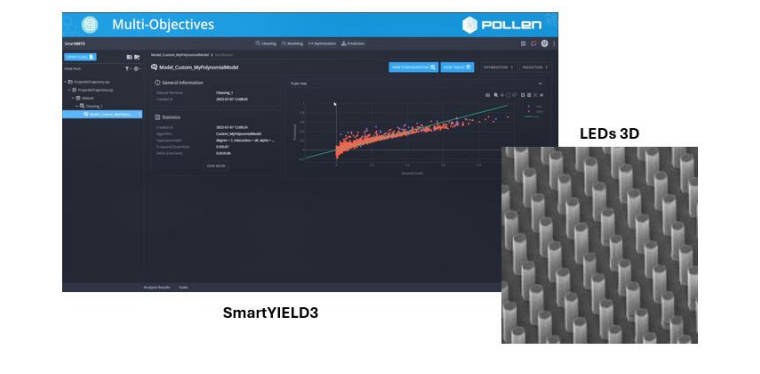The CLEDIA project, co-financed by the Auvergne-Rhône-Alpes A group of logos with different names
Region and Bpifrance has just been completed after three years of collaborative innovation between Pollen, Aledia and the laboratories at the University of Clermont Auvergne (LIMOS and LMBP). This ambitious project aimed to improve the efficiency of Aledia's microLEDs through the integration of artificial intelligence dedicated to the optimization of epitaxy processes.
Led by Pollen, a company specializing in AI-based process optimization software, CLEDIA has developed and deployed the SmartYIELD3 software platform, which is capable of automatically modeling and proposing new technological recipes from industrial data (Digital Twin). The technology has been tested in a real-world environment on several batches of wafers supplied by Aledia, the world leader in nanowire 3D LEDs, as illustrated below.

The core of the project was the use of artificial intelligence as a co-pilot for epitaxy experts. SmartYIELD3 enabled the implementation of multi-objective prediction models, the exploration of process parameter space, and the proposal of optimized recipes, while integrating the physical and industrial constraints of the MOCVD epitaxy process.
A solid foundation for the next industrial steps
CLEDIA has enabled significant advances in data structuring, predictive modeling, and partial automation of technological recipe exploration. Aledia’s pilot line has continued to mature industrially, and the tools developed in the framework of the project are now ready to be deployed in a broader production environment.
The project has also validated advanced methods for time series processing, data visualization, and the generation of optimized experimental designs
An exemplary collaboration
CLEDIA is a great example of successful cooperation between industry and academia. The LIMOS and LMBP labs brought their expertise in mathematical modeling and machine learning to the table, complementing Pollen's business skills and Aledia's industrial data.
What's next?
The technological building blocks developed by CLEDIA are now integrated into Pollen's Smart3 software suite, particularly in its SmartYield3 module, which is used in other sectors such as semiconductors, electronic displays, and innovative materials in the broadest sense.
For Aledia, the next step is to integrate big data and artificial intelligence into production lines (advanced metrology, yield improvement, predictive maintenance, etc.)
Future collaborations with Pollen are therefore being explored to extend this work. This will help accelerate Aledia's growth.
TrendForce 2025 Micro LED Display and Non-Display Application Market Analysis
Release: 29 May / 30 November 2025
Languages: Traditional Chinese / English
Format: PDF
Page: 119
TrendForce 2024 Near-Eye Display Market Trend and Technology Analysis
Release Date:2024 / 07 / 31
Languages:Traditional Chinese / English
Format:PDF
Page:164
|
If you would like to know more details , please contact:
|












